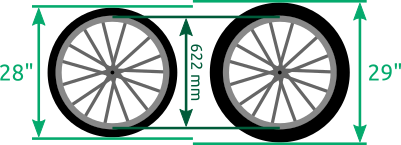Last updated: 2025-02-16
You want to know the max tire size for rim width?
You are looking for a rim width tire size calculator?
How to measure rim width?

To determine the tire width on the bike, you can measure it yourself as shown in the diagram above. Alternatively, you can determine the tire width based on the casing labeling. The following link will help you to find out quickly.
On the road bike, a tire width of 23 mm is common. Occasionally, there are wider tires.
Tire widths of 37 to 52 mm are typically used here.
Mountain bikes have the widest tires. Their widths usually are between 51 and 64 mm.
For bicycles with electric motor, the tire widths are basically based on the respective bicycle type, see above. Since e-bikes travel faster and carry more weight due to the additional technology, additional attention must be paid to the appropriate approval by the manufacturer. For example, the tire manufacturer Schwalbe marks suitable tires with E-25 and E-50.
Usually, it is possible to mount wider tires on the same bike rim. The most important starting point is the inner tire diameter, that is specified by the bicycle rim on the wheel. It is identical to the nominal rim diameter or outer diameter of the rim shoulder where the tire bead rests on the rim. If you want to fit a wider tire, it must therefore have the same inner tire diameter as the previous tire.
The second important point is the rim inner width. The tire width should be approximately between 1.5 and 2.5 times the rim inner width. A more precise orientation is given by the rim inner width table below.
The maximum usable tire width is limited by several factors:
The bicycle fork has a certain width and thus provides a first technical limitation of the tire width. Wider bike tires are also higher, so the distance to the fork crown can also become too small.
If a rim brake is mounted, the friction pads limit the possible tire widths. It is best to measure the available space with the brake applied and leave some air as the friction pads are still wearing off.
If fenders are used, they only cover a certain tire width. The mounting braces of the fenders can also limit the maximum width of the tire.
If the tire width is too large in relation to the rim width, the tire wall will be stressed too much, a sidewall fracture may occur and the tire will burst open. For reasonable tire widths, see the rim inner width table below.
Usually yes. As a first step, I would use the tire labeling to determine the inner tire diameter and get an idea of available narrower tires. The following link lists available alternative tire widths for your tire size.
The above-mentioned technical limitations due to other parts of the bike, of course, do not cause problems with narrower tires. However, the ratio to the rim inner width must also be observed here in order to avoid pinch holes. The following section lists recommended tire widths depending on the rim inner width.
The ETRTO standard recommends tire widths depending on the rim inner width. But what is the inner width of a rim?

The rim inner width refers to the distance between the two inner sides of a rim. The above figure shows where it is measured.
The following tire width chart shows the recommended tire widths according to ETRTO. The data refers only to hooked rims, as these are the most common today.
| Rim inner width in mm | Recommended tire widths in mm |
|---|---|
| 13 | 18 – 25 |
| 15 | 23 – 32 |
| 17 | 25 – 50 |
| 19 | 28 – 57 |
| 21 | 35 – 62 |
| 23 | 37 – 64 |
| 25 | 44 – 64 |
| 27 | 47 – 64 |
| 29 | 54 – 64 |
As long as you use the recommended tire widths, you should be on the safe side. Depending on the stability of the tire casing, some tire manufacturers allow even larger tire widths. Please check the manufacturer's specification in each individual case.
Example: Both, 28-inch tires and 29-inch tires are usually mounted on a wheel with 622 mm nominal rim diameter. The following diagram illustrates the differences.

The inch size of the bicycle tire refers to the outer diameter, while for the rim the inner diameter of the tire is relevant. When measuring the outside diameter, the tire height is added on both sides; in contrast, the inner diameter does not include the tire height.
In addition, the tire height is approximately equal to the tire width, since the tire is almost circular. So if you choose a wider bicycle tire while keeping the rim size the same, this increases the outer diameter of the tire as shown above.
Advantages of wide tires: Because of their larger contact area with the ground, wide tires have better traction and ride over smaller bumps more easily, often perceived as providing a more comfortable ride. This makes them more suitable for off-road driving and on dirt roads.
Disadvantages of wide tires: Narrow tires are lighter and form less rotating mass. They therefore accelerate better and are more agile.
The optimal tire pressure depends on several factors. The tire pressure calculator helps to find the right tire pressure and contains numerous information and tips.